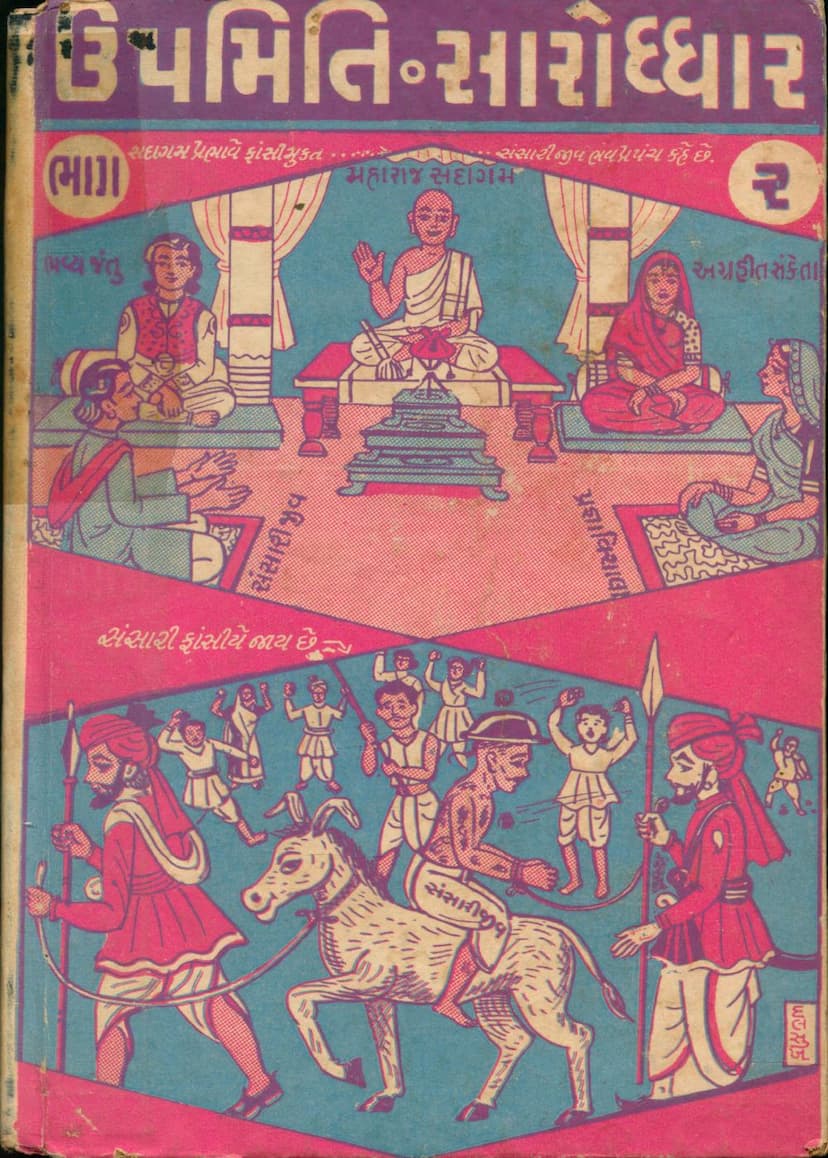Upmiti Saroddhar Part 02
Added to library: September 2, 2025

Summary
This comprehensive summary synthesizes the provided Jain text, "Upmiti Saroddhar Part 02," authored by Kshamasagar and published by Vardhaman Jain Tattvagyan Pracharak Vidyalay. The book is a Gujarati translation of the "Upamiti Bhavaprapancha Kathasaroddhar" by Acharya Shree Devendrasuriji. The summary focuses on the content, characters, and philosophical underpinnings presented in the text, particularly within the context of Jain teachings.
Overall Purpose and Context:
The publication aims to make profound Jain philosophical truths accessible to the general public by presenting them in the vernacular language (Gujarati). It acknowledges the support and blessings of Acharya Shree Vijayharshsurishwarji Maharaj's disciple, Gyani Mangalvijayji Ganivar, as the inspirational force behind the initiative. The translation is undertaken by Muni Kshamasagarji, a disciple of Acharya Shree Kailassagarsurijiy. The publication is dedicated to the memory of Smt. Sharadaben, wife of Seth Shree Sumitilal Chotalal, signifying a charitable contribution.
Content Breakdown:
The text is a detailed narrative that explores Jain philosophical concepts through allegorical stories and character portrayals. It aims to illustrate the cycle of birth and death (Bhavachakra) and the path to liberation. The summary highlights the following key aspects:
-
Upamiti Bhavaprapancha Kathasaroddhar: The original work is a vast text, and "Upmiti Bhavaprapancha Kathasaroddhar" is a condensed version. This Gujarati translation further distills the essence of the condensed work.
-
Narrative Structure: The book is structured into several "Prastavs" (chapters or sections), each focusing on different stages of spiritual evolution or specific philosophical themes. The provided text specifically details parts of the Fourth and Fifth Prastavs, offering insights into the characters and events within these sections.
-
Characters and Allegories: The text introduces a rich tapestry of characters, many of whom are allegorical representations of spiritual states, virtues, vices, and karmic influences:
- Ripudarana: Represents the soul entangled in worldly attachments and ego. His journey illustrates the consequences of pride, lack of discipline, and negative associations.
- Shailraj & Mrushavad: These characters represent the negative influences of pride (Shailraj, having eight heads symbolizing eight types of pride) and falsehood/deceit (Mrushavad). Their friendship with Ripudarana leads to his downfall.
- Narasundari: A virtuous princess whose marriage to Ripudarana is contingent on artistic skill. Her fate highlights the suffering caused by ignorance and the consequences of associating with negative influences.
- Vichakshanacharya & Jad: These represent contrasting aspects of intellect and spiritual inclination. Vichakshanacharya embodies wisdom and detachment, while Jad represents ignorance and attachment.
- Mahamah, Ragkeshari, Dvesh Gajendra, Moh, Maya, etc.: These are personifications of various passions and karmic forces that bind the soul. Their interactions and influences are intricately described, illustrating the complexities of the Bhavachakra.
- Charitradharma, Santosh, Vairagya: These represent the path to liberation, embodying virtues like righteousness, contentment, and detachment, which are crucial for spiritual progress.
- The Seven Rakshasis (Jara, Rucha, Smriti, Khalta, Kurupta, Daridrata, Durbhagta): These allegorical figures represent the afflictions and negative states that plague the soul on its journey through Samsara.
-
Philosophical Themes: The narrative delves into several core Jain philosophical concepts:
- Karmic Law: The text implicitly and explicitly illustrates the law of karma, where actions have consequences, shaping one's destiny across lifetimes. The suffering of characters like Ripudarana and Vamdeva is a direct result of their past actions and negative associations.
- Bhavachakra (Cycle of Birth and Death): The allegorical journeys of the characters represent the soul's passage through various states of existence, driven by desires, attachments, and karmic forces.
- The Importance of Right Conduct (Samayik, Sheel, Tapa, Bhav): The virtuous characters like Vichakshanacharya and the path shown by the Jain Nagar illustrate the significance of ethical conduct, self-discipline, penance, and spiritual contemplation in overcoming worldly afflictions.
- Detachment (Vairagya): The text emphasizes the gradual development of detachment from worldly pleasures as a key to spiritual liberation.
- The Nature of Reality: Through the allegories, the text attempts to unveil the illusory nature of worldly pleasures and the true essence of the soul.
- The Path to Liberation: The presence of virtuous characters and the emphasis on practices like right knowledge, right faith, and right conduct (Samayik, Sheel, Tapa, Bhav) point towards the Jain path to Moksha.
-
Literary Style: The language is descriptive and engaging, using metaphors and allegories to convey complex ideas. The narrative aims to evoke emotional responses from the reader, prompting introspection and spiritual reflection. The author also engages in comparative literary critique, highlighting the superiority of Indian literature over Western literature in terms of spiritual depth and artistic merit.
Key Sections and Their Significance:
- Fourth Prastav: Introduces Ripudarana, Shailraj, and the beginning of their misguided friendship, leading to Ripudarana's ego and downfall. It also touches upon Vamdeva's eventual negative path.
- Fifth Prastav: Focuses on the lineage of Dharma, the development of Vimal's dispassion, and his eventual renunciation. It also introduces the characters of Vamdeva and his negative influences.
Publisher and Translator:
- Publisher: Shree Vardhman Jain Tattvagyan Pracharak Vidyalay, Shivganj, Rajasthan.
- Translator: Muni Kshamasagarji.
- Inspiration: Panyas Pravar Shree Mangalvijayji Ganivar.
Conclusion:
"Upmiti Saroddhar Part 02" is presented as a guide for spiritual upliftment, encouraging readers to understand the intricacies of the Bhavachakra and to pursue the path of righteousness and liberation by shedding attachments and cultivating virtues. The translation aims to make these timeless teachings accessible and impactful for a wider audience.